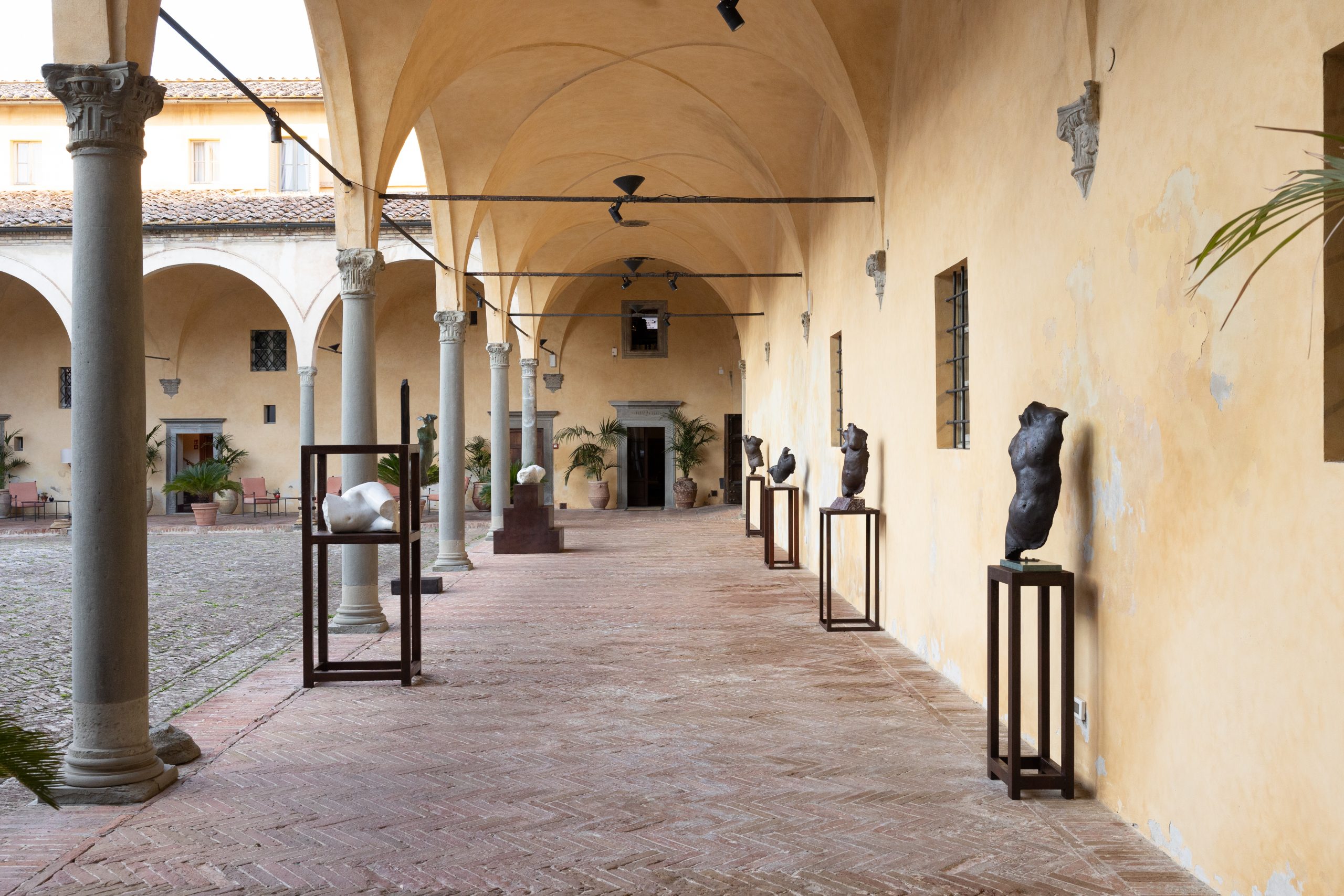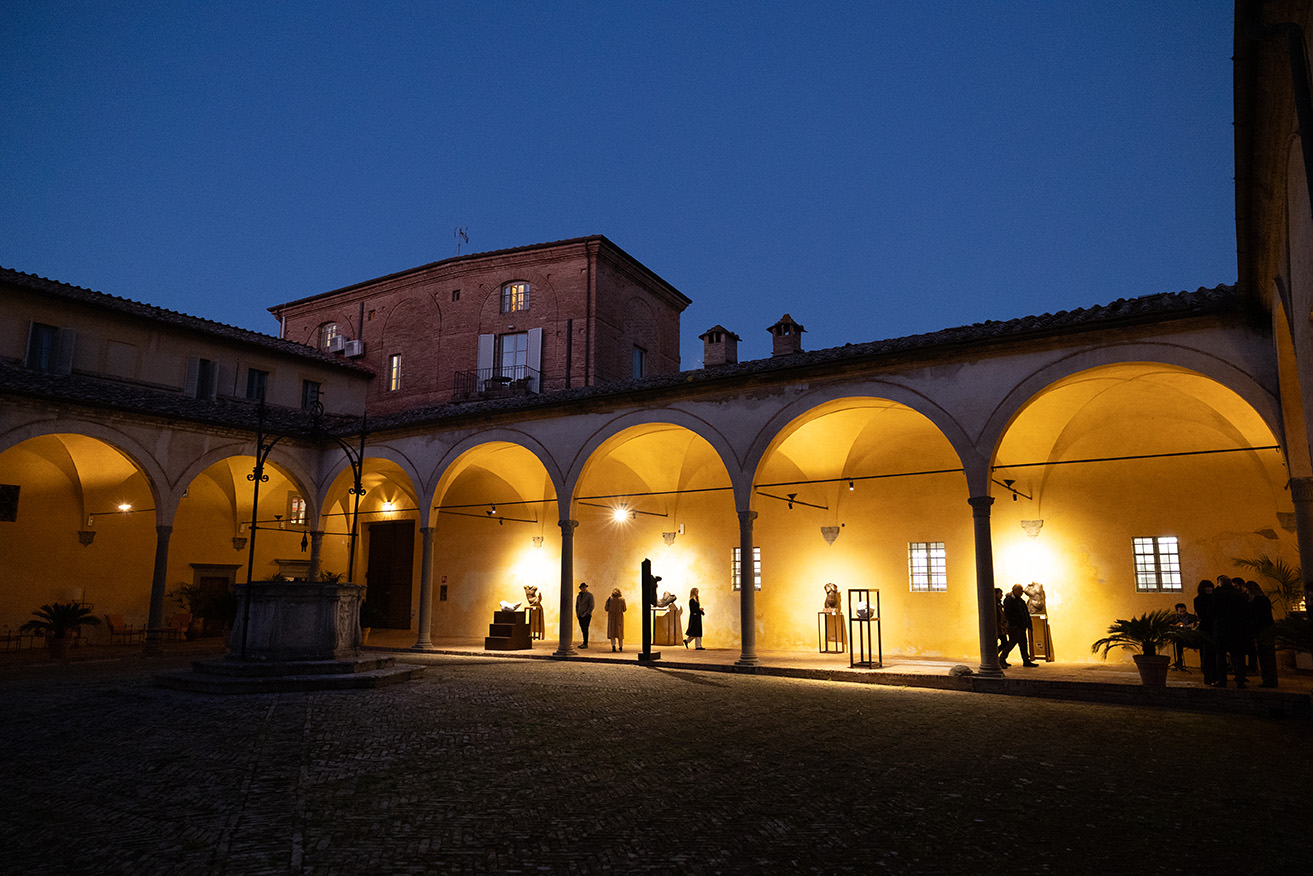29 novembre 2024 | La Certosa di Maggiano – Siena
30 novembre 2024 – 30 marzo 2025
“Kairos”, mostra personale dell’artista Filippo Galgani in collaborazione con La Certosa di Maggiano.
Violetti Arte Contemporanea è lieta di presentare la mostra personale di Filippo Galgani “Kairos”, in collaborazione con la Certosa di Maggiano. 12 sculture in marmo, bronzo e geomalta saranno esposte all’interno degli spazi trecenteschi dell’ex monastero dal 29 novembre 2024 al 30 marzo 2025.
Lacerti poetici, relitti di prassiletica bellezza, brani di un passato perduto reinterpretato con una sensibilità moderna: l’estetica del frammento permea l’arte di Galgani. In un dialogo continuo tra antico e contemporaneo, l’artista dà vita a corpi di pura bellezza. Classiche per rigore di impostazione, cariche di ellenistiche influenze, le opere di Galgani fermano l’attimo della tensione emotiva.
Il Kairos è la personificazione e divinizzazione del tempo opportuno o del momento giusto, dell’istante che sfiora l’eterno. «La storia è oggetto di una costruzione in cui il luogo non è costituito dal tempo omogeneo e vuoto, ma da quello riempito dell’adesso». Così scriveva in una delle sue note Walter Benjamin. Ed in questo sta la sostanziale differenza tra Kronos e Kairos. Al tempo lineare, monotono, dell’orologio si affianca l’evento, l’occasione irripetibile, l’apertura della possibilità, il tempo di tipo qualitativo.
Galgani porta in scultura l’attimo in forma archetipica e scrive una poesia che restituisce dignità alla storia. L’arte di Galgani strappa al tempo lineare, coglie l’essenziale e scopre il Kairos, ciò che è degno di essere ricordato, che non è in rapporto con il tempo ma con l’eterno o, meglio, ciò che nel tempo è eternamente degno di essere.
Le ricerche condotte dall’artista sul corpo umano sono basate sullo studio di armonici rapporti proporzionali. Le figure partono dal naturalismo ma sono ricondotte a forme ideali. Raggiungono così un naturalismo idealizzato. L’elemento centrale è la ricerca della bellezza assoluta come simbolo di perfezione spirituale. Non vuole avere corrispondenza con il reale ma, grazie all’ispirazione costante al mondo antico, può essere un valido strumento per elevare l’animo dell’osservatore verso i più alti valori spirituali.
La firma inconfondibile di Galgani è il costante richiamo al mondo classico, dove soggetti della mitologia come Nausicaa, Antinoo, Proserpina vengono ripensati e ridefiniti attraverso uno studio tra il reperto e l’archetipo. Le sue opere non si presentano mai intatte o perfettamente concluse ma sono frammentate, spezzate, con parti omesse o eliminate. Ecco che si attiva una riflessione sul concetto di non finito, non come ideale michelangiolesco ma come possibilità di immaginare oltre, lasciando l’opera libera di espandersi ed evolversi.
Galgani, nostalgico di un paradiso perduto, di un’ideale di antico splendore come perfetto equilibrio fra armonia e misura, ricerca la bellezza perfetta, incorruttibile nel tempo, per cui immortale.
La rappresentazione della figura umana testimonia un desiderio di perfezione spirituale. Galgani parla del mito e scolpisce la storia richiamando il concetto di Humanitas: un valore etico accumunabile con la filantropia ma da intendere anche come Paideia, un processo spirituale e materiale, uno sviluppo etico e morale dell’uomo per raggiungere le più alte virtù.
Imprescindibile è il binomio osmotico tra l’architettura della storica Certosa di Maggiano e le opere di Galgani. Due realtà che si fondono, instaurando un rapporto dialettico. La Certosa venne fondata nel 1316 per volere del cardinale Riccardo Petroni come luogo di accoglienza e rifugio e il modello è stato abbracciato e mantenuto nei secoli.
Le opere di Galgani vivono nel tempo ma sono manifestazione del Kairos; sono l’attimo che, nella sua perfezione, invita a meditare sulla crisi di certezze dell’uomo contemporaneo. «Codesto solo oggi possiamo dirti, / ciò che non siamo, ciò che non vogliamo» (Montale, Ossi di seppia). L’unica verità è la coscienza dell’impossibilità di avere qualche certezza, di un mondo indecifrabile e inconoscibile, in cui però l’arte è la vera sola possibilità di conoscenza ed elevazione. Galgani, moderno aedo, profeta contemporaneo dalla memoria antica, conoscendo le cose che furono, che sono e che saranno, racconta di storie individuali che si fanno paradigma di valori universali.






